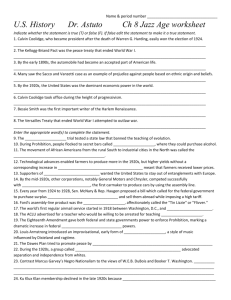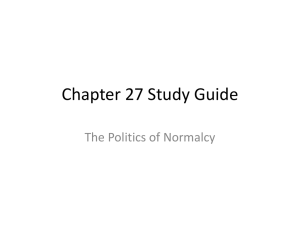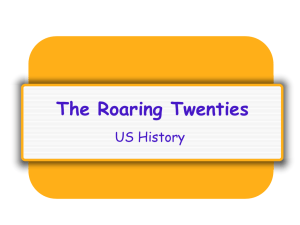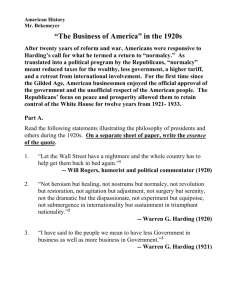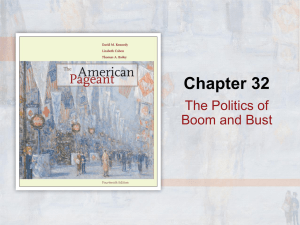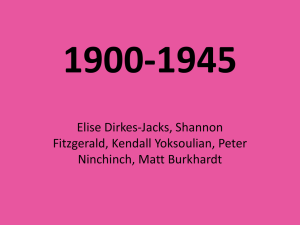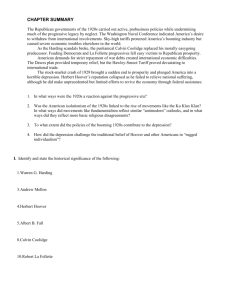Calvin Coolidge
advertisement
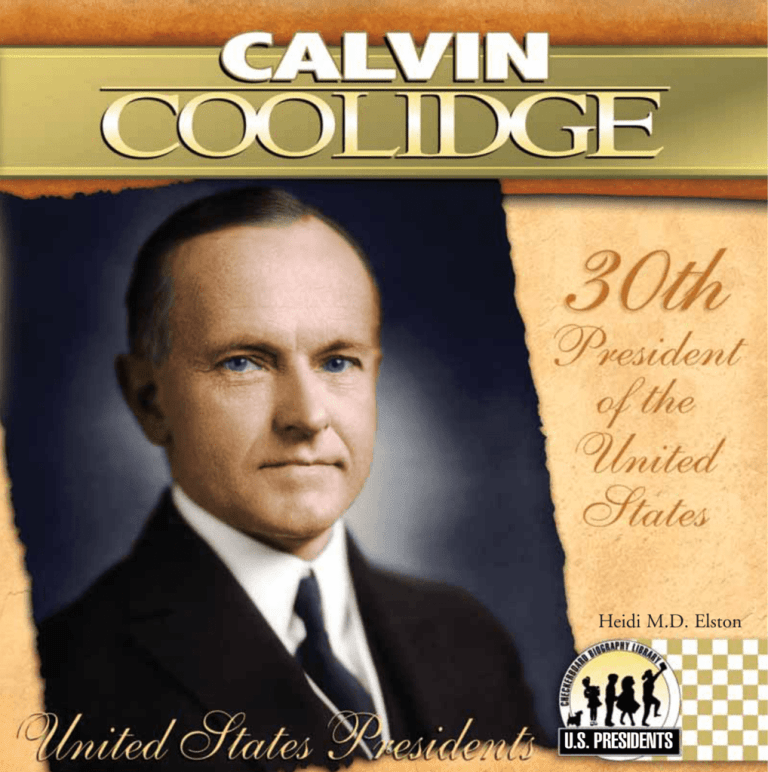
Heidi M.D. Elston U.S. PRESIDENTS Calvin Coolidge.qxp:US Presidents MASTER 9/30/08 10:32 AM Page 1 Calvin Coolidge Heidi M.D. Elston Calvin Coolidge.qxp:US Presidents MASTER 9/30/08 10:32 AM Page 2 visit us at www.abdopublishing.com Published by ABDO Publishing Company, 8000 West 78th Street, Edina, Minnesota 55439. Copyright © 2009 by Abdo Consulting Group, Inc. International copyrights reserved in all countries. No part of this book may be reproduced in any form without written permission from the publisher. The Checkerboard Library™ is a trademark and logo of ABDO Publishing Company. Printed in the United States. Cover Photo: Getty Images Interior Photos: AP Images pp. 8, 9, 12, 25; Corbis pp. 15, 16, 17, 22, 23, 27, 29; Getty Images pp. 5, 10, 11, 13, 19, 21, 28; iStockphoto p. 32; Library of Congress p. 18; Picture History p. 24 Editor: BreAnn Rumsch Art Direction & Cover Design: Neil Klinepier Interior Design: Jaime Martens Library of Congress Cataloging-in-Publication Data Elston, Heidi M. D., 1979Calvin Coolidge / Heidi M.D. Elston. p. cm. -- (The United States presidents) Includes index. ISBN 978-1-60453-448-1 1. Coolidge, Calvin, 1872-1933--Juvenile literature. 2. Presidents--United States--Biography-Juvenile literature. I. Title. E792.E45 2009 973.91’5092--dc22 [B] 2008039218 Calvin Coolidge.qxp:US Presidents MASTER 9/30/08 10:32 AM Page 3 Contents Calvin Coolidge . . . . . . . . . . . . . . . . . . . . . . . . . . . . . . . 4 Timeline . . . . . . . . . . . . . . . . . . . . . . . . . . . . . . . . . . . . 6 Did You Know? . . . . . . . . . . . . . . . . . . . . . . . . . . . . . . . 7 Young Calvin . . . . . . . . . . . . . . . . . . . . . . . . . . . . . . . . . 8 Entering Politics . . . . . . . . . . . . . . . . . . . . . . . . . . . . . . 10 Rising in Politics . . . . . . . . . . . . . . . . . . . . . . . . . . . . . 12 Governor Coolidge . . . . . . . . . . . . . . . . . . . . . . . . . . . 14 Death of a President . . . . . . . . . . . . . . . . . . . . . . . . . . . 16 Cleaning House . . . . . . . . . . . . . . . . . . . . . . . . . . . . . . 18 “Keep Cool with Coolidge” . . . . . . . . . . . . . . . . . . . . . 20 President Coolidge . . . . . . . . . . . . . . . . . . . . . . . . . . . . 22 Coolidge Prosperity . . . . . . . . . . . . . . . . . . . . . . . . . . . 24 Coolidge Goes Home . . . . . . . . . . . . . . . . . . . . . . . . . 26 Office of the President . . . . . . . . . . . . . . . . . . . . . . . . . 30 Presidents and Their Terms . . . . . . . . . . . . . . . . . . . . . 34 Glossary . . . . . . . . . . . . . . . . . . . . . . . . . . . . . . . . . . . . 38 Web Sites . . . . . . . . . . . . . . . . . . . . . . . . . . . . . . . . . . . 39 Index . . . . . . . . . . . . . . . . . . . . . . . . . . . . . . . . . . . . . . 40 Calvin Coolidge.qxp:US Presidents MASTER 9/30/08 10:33 AM Page 4 Calvin Coolidge Calvin Coolidge became the thirtieth U.S. president in 1923. During the 1920s, the U.S. economy flourished. The stock market was booming, which attracted new investors. Also, most people had good jobs and owned their own homes and cars. Many Americans called these good times “Coolidge prosperity.” Americans praised President Coolidge for their good fortune. But shortly after he left office, it all came crumbling down. In 1929, the country’s economy failed. This led to the Great Depression. Before becoming president, Coolidge was active in Massachusetts politics. He served as a state representative and a state senator. He became lieutenant governor and then governor. Coolidge never lost a major election. And, he worked hard for the citizens he represented. In 1921, Coolidge became vice president of the United States. Two years later, a shocking event made Coolidge president. President Warren G. Harding died while in office. Vice President 4 Calvin Coolidge.qxp:US Presidents MASTER Coolidge then took the oath of office and became president. As president, Coolidge was honest and hardworking. He did what he thought was best for Americans. 9/30/08 10:33 AM Page 5 Calvin Coolidge.qxp:US Presidents MASTER 9/30/08 10:34 AM Page 6 Timeline 1872 - On July 4, John Calvin Coolidge was born in Plymouth, Vermont. 1895 - Coolidge graduated from Amherst College in Amherst, Massachusetts. 1897 - Coolidge became a lawyer. 1898 - In Massachusetts, Coolidge was elected to the Northampton City Council. 1905 - On October 4, Coolidge married Grace Anna Goodhue. 1906 - Coolidge was elected to the Massachusetts House of Representatives. 1909 - Coolidge was elected to his first term as mayor of Northampton. 1912 - Coolidge was elected to the Massachusetts state senate. 1916 - On January 6, Coolidge became lieutenant governor of Massachusetts. 1919 - Coolidge took office as governor of Massachusetts on January 1; he helped end the Boston Police Strike. 1921 - On March 4, Coolidge became vice president of the United States under Warren G. Harding. 1923 - President Harding died on August 2; on August 3, Coolidge became the thirtieth U.S. president. 1925 - On March 4, Coolidge was inaugurated president. 1927 - Coolidge announced he would not seek reelection. 1928 - Coolidge supported the Kellogg-Briand Pact. 1933 - On January 5, Calvin Coolidge died. 6 Calvin Coolidge.qxp:US Presidents MASTER 9/30/08 10:34 AM Page 7 Did You Know? Calvin Coolidge loved animals. He even owned a pet raccoon that he walked on a leash! Her name was Rebecca. In 1923, President Coolidge lit the first national Christmas tree on the White House lawn. On March 4, 1925, Chief Justice William Taft of the U.S. Supreme Court gave the oath of office to Coolidge. That day, Taft became the first former president to give the presidential oath. Coolidge was a quiet man. Once, a woman bet she could get more than two words out of him. When she told Coolidge this he replied, “You lose.” On August 10, 1927, President Coolidge attended the formal dedication of Mount Rushmore in South Dakota. There, Coolidge gave a speech and promised federal funding for the monument. 7 Calvin Coolidge.qxp:US Presidents MASTER 9/30/08 10:35 AM Page 8 Young Calvin John Calvin Coolidge was born in Plymouth, Vermont, on July 4, 1872. His parents were John Calvin and Victoria Moor Coolidge. They called their son Calvin to avoid confusion. Calvin had a younger sister named Abigail. She was his closest friend. John was a farmer and a storekeeper. He was also active in local politics. Victoria loved poetry. She taught Calvin and Abigail to read. When Calvin was only 12 years old, his mother died. Calvin was deeply saddened. Young Calvin helped his father on the farm. He drove the mowing machine, tended cattle, and planted FAST FACTS potatoes. Calvin also had BORN - July 4, 1872 WIFE - Grace Anna Goodhue time to play and have (1879–1957) fun. He skated, CHILDREN - 2 POLITICAL PARTY - Republican sledded, and took AGE AT INAUGURATION - 51 YEARS SERVED - 1923–1929 VICE PRESIDENT - Charles Dawes DIED - January 5, 1933, age 60 Seven-year-old Calvin 8 Calvin Coolidge.qxp:US Presidents MASTER 9/30/08 10:35 AM Page 9 Calvin (standing, second from left) with his graduating class at Black River Academy hayrides in the winter. In the summer Calvin loved to fish, swim, and ride horses. Calvin attended Black River Academy in Ludlow, Vermont. His favorite subjects were Latin and history. Shortly before his graduation in 1890, Abigail died. Again, Calvin was heartbroken. 9 Calvin Coolidge.qxp:US Presidents MASTER 9/30/08 10:35 AM Page 10 Entering Politics In 1891, Coolidge entered Amherst College in Amherst, Massachusetts. He graduated in 1895 and moved to Northampton, Massachusetts. There, he studied law at the Hammond and Field law firm. Coolidge became a lawyer in 1897. About seven months later, he opened a law office in Northampton. During this time, Coolidge became active in the Republican Party. In 1898, he was elected to the Northampton City Council. Two years later, Coolidge became the city solicitor, or lawyer. He was reelected to this position the next year. In Northampton, Coolidge met a young woman named Grace Anna Goodhue. Grace had been born in Burlington, Vermont. She taught at the Clarke School for the Deaf in Northampton. 10 Grace Coolidge Calvin Coolidge.qxp:US Presidents MASTER 9/30/08 10:55 AM Page 11 Coolidge was shy and quiet, but Grace was the opposite. She was warm and outgoing. The two married on October 4, 1905. They shared a loving relationship. Soon, the Coolidges had two sons. John was born in 1906. Calvin Jr. followed in 1908. The Coolidge family 11 Calvin Coolidge.qxp:US Presidents MASTER 9/30/08 10:35 AM Page 12 Rising in Politics Meanwhile, Coolidge was still active in politics. But he wasn’t like most politicians. He rarely smiled. And, he didn’t flatter people to get their votes. Coolidge was smart and trustworthy. People liked his honesty. In 1906, Coolidge was elected to the Massachusetts House of Representatives. There, he fought for the rights of workers and women. Coolidge reduced working hours, and he supported women’s right to vote. He won reelection the next year. In 1909, Coolidge was elected mayor of Northampton. He increased wages for teachers and helped lower taxes. The next Young Coolidge year, he won reelection. Coolidge was elected to the Massachusetts state senate in 1912. As a senator, Coolidge was chairman of the Committee on Legal 12 Calvin Coolidge.qxp:US Presidents MASTER 9/30/08 10:36 AM Page 13 Affairs and the Committee on Agriculture. Coolidge also helped resolve a strike at the American Woolen Company. Later, he served as senate president for two terms. Next, Coolidge ran for lieutenant governor of Massachusetts. He won the election in 1915 and took office on January 6, 1916. As lieutenant governor, Coolidge delivered speeches on local and state issues. He was reelected to this position twice. The Coolidges lived in the left half of this duplex in Northampton. Calvin Coolidge.qxp:US Presidents MASTER 9/30/08 10:36 AM Page 14 Governor Coolidge In 1918, Coolidge ran for governor of Massachusetts. He narrowly won the election. Coolidge took office on January 1, 1919. Governor Coolidge soon won national attention for his role in the Boston Police Strike. That year, more than 1,100 of the 1,500 city police officers went on strike. Two days of disorder followed. Then, Governor Coolidge called in the state guard to control the city. Police Commissioner Edwin U. Curtis decided the striking officers would lose their jobs. He said they had abandoned their jobs by going on strike. Labor leader Samuel Gompers protested this decision. He wanted the strikers to get their jobs back. But Governor Coolidge agreed with Curtis. “There is no right to strike against the public safety by anybody, anywhere, anytime,” Coolidge said. People across the country praised the governor for his tough stand. That year, he was reelected by a record vote. During the Boston Police Strike, eight city residents were killed. More than 20 were seriously wounded. 14 Calvin Coolidge.qxp:US Presidents MASTER 9/30/08 10:36 AM Page 15 Calvin Coolidge.qxp:US Presidents MASTER 9/30/08 10:36 AM Page 16 Death of a President In 1920, Republican Party leaders nominated Warren G. Harding to run for president. They chose Coolidge to run for vice president. Harding faced off against Democratic governor James M. Cox of Ohio. Cox’s running mate was Assistant Secretary of the Navy Franklin D. Roosevelt. The 1920 election marked the first time women could vote. In the past, Harding and Coolidge had each fought for women’s rights. Women remembered this support and voted for them. This helped Harding and Coolidge win the race. Harding was inaugurated the twenty-ninth U.S. president on March 4, 1921. That day, Coolidge became vice president. As vice president, Coolidge was in charge of the U.S. Senate. He controlled debates and managed the senators. Coolidge also attended President Harding’s cabinet meetings. 16 Calvin Coolidge.qxp:US Presidents MASTER 9/30/08 11:00 AM Page 17 Never before in U.S. history had a president been sworn in by his father. In summer 1923, Coolidge visited his father in Vermont. One night, Coolidge was awoken with some shocking news. President Harding had died. At 2:47 AM on August 3, Coolidge was sworn into office by his father, a notary public. Then, he turned out the lights and went back to bed. 17 Calvin Coolidge.qxp:US Presidents MASTER 9/30/08 10:36 AM Page 18 Cleaning House Harding’s administration had been filled with many dishonest people. Other government officials feared they were taking bribes and lying to the nation. President Coolidge hired two lawyers to conduct investigations. They brought to court anyone involved in political crimes. Americans liked President Coolidge’s swift action and firm leadership. He restored the country’s trust in government. Coolidge continued Harding’s policy of supporting U.S. businesses. He kept tariffs high to help American manufacturers. He also reduced income taxes and kept government spending low. As a result, President Coolidge reduced the Warren G. Harding national debt by about $1 billion a year. 18 Calvin Coolidge.qxp:US Presidents MASTER 9/30/08 10:37 AM Page 19 President Coolidge worked hard to quickly remove all dishonesty from the White House. Calvin Coolidge.qxp:US Presidents MASTER 9/30/08 10:37 AM Page 20 “Keep Cool with Coolidge” Tragedy soon struck the Coolidge family. In 1924, 16-year-old Calvin Jr. died of a foot infection. Coolidge suffered from the loss of his son. He said, “When he went, the power and the glory of the presidency went with him.” Coolidge was tired and sad. Yet he entered the 1924 election for president. Bureau of the Budget director Charles Dawes was his running mate. The Democrats chose John W. Davis of West Virginia to run for president. Nebraska governor Charles W. Bryan was his running mate. Unhappy Republicans and Democrats formed the Progressive Party. They nominated Wisconsin senator Robert M. La Follette for president. Montana senator Burton K. Wheeler was chosen for his running mate. Coolidge campaigned with the slogan “Keep Cool with Coolidge.” Americans were happy with him, and he easily won the election. SUPREME COURT APPOINTMENT HARLAN FISKE STONE - 1925 20 Calvin Coolidge.qxp:US Presidents MASTER 9/30/08 10:37 AM Page 21 Charles Dawes Calvin Coolidge.qxp:US Presidents MASTER 9/30/08 10:37 AM Page 22 President Coolidge Coolidge was inaugurated on March 4, 1925. Again, he maintained his firm stand on taxes and government spending. Businesses continued to grow and stock market prices rose. Twice, Congress tried to pass the McNary-Haugen bill. This bill would help farmers get out of debt. But Coolidge stopped it both times. He worried the bill would raise prices for consumers. Some historians believe the bill might have helped prevent the Great Depression. President Coolidge also opposed a bonus bill for soldiers who had fought in World War I. Congress passed the bill over him. The Veterans Bonus Act provided these former soldiers with insurance policies. In 1928, Coolidge supported the Kellogg-Briand Pact. This d Pact Kellogg-Brian 22 Calvin Coolidge.qxp:US Presidents MASTER 9/30/08 10:37 AM Page 23 agreement prevented using war to settle quarrels between countries. Sixty-two nations signed the treaty. It is named for U.S. Secretary of State Frank B. Kellogg and French foreign minister Aristide Briand. President Coolidge signing the Kellogg-Briand Pact Calvin Coolidge.qxp:US Presidents MASTER 9/30/08 10:37 AM Page 24 Coolidge Prosperity Under President Coolidge’s leadership, America’s economy flourished. Big businesses such as mining and banking grew even larger. Factories shipped huge amounts of goods. Stores spread across the country. And, sales of buildings and land in nearly every town boomed. Coolidge prosperity gave many Americans a better life. Workers enjoyed higher pay and a shorter workweek. Some workers even received paid vacations and free medical care. However, not everyone benefited from Coolidge prosperity. Nearly 2 million Americans were without jobs. Farmers also suffered greatly. Their prices fell and they sold less in foreign markets. Still, Coolidge opposed farm relief. 24 Calvin Coolidge.qxp:US Presidents MASTER 9/30/08 10:37 AM Page 25 President Coolidge’s Cabinet FIRST TERM SECOND TERM August 3, 1923–March 4, 1925 March 4, 1925–March 4, 1929 • STATE – Charles Evans Hughes • TREASURY – Andrew W. Mellon • WAR – John Wingate Weeks • NAVY – Edwin Denby Curtis Dwight Wilbur (from March 18, 1924) • ATTORNEY GENERAL – Harry Micajah Daugherty Harlan Fiske Stone (from April 9, 1924) • INTERIOR – Hubert Work • AGRICULTURE – Henry Cantwell Wallace Howard Mason Gore (from November 21, 1924) • COMMERCE – Herbert Hoover • LABOR – James John Davis • STATE – Frank B. Kellogg • TREASURY – Andrew W. Mellon • WAR – John Wingate Weeks Dwight F. Davis (from October 14, 1925) • NAVY – Curtis Dwight Wilbur • ATTORNEY GENERAL – John Garibaldi Sargent • INTERIOR – Hubert Work Roy Owen West (from January 21, 1929) • AGRICULTURE – William Marion Jardine • COMMERCE – Herbert Hoover William Fairfield Whiting (from December 11, 1928) • LABOR – James John Davis Coolidge (seated, third from left) with his cabinet in 1927 Calvin Coolidge.qxp:US Presidents MASTER 9/30/08 10:37 AM Page 26 Coolidge Goes Home In 1927, President Coolidge released a historic statement. He said, “I do not choose to run for president in 1928.” The nation was stunned. Times were good. Why wouldn’t he want to be reelected? Coolidge did not explain his decision. Coolidge left the White House in March 1929 and retired to Northampton. There, he spent time with his family. He also wrote magazine and newspaper articles. And, he wrote a book called The Autobiography of Calvin Coolidge. Coolidge served as a director of the New York Life Insurance Company. In addition, he was president of the American Antiquarian Society. This historical society collects and preserves records of the lives and activities of Americans. For greater privacy, the Coolidges eventually moved to a Northampton estate called The Beeches. There, gates kept tourists at a distance. Coolidge also had plenty of room to walk and play with the family’s dogs. 26 Calvin Coolidge.qxp:US Presidents MASTER 9/30/08 10:38 AM Page 27 The Coolidges purchased The Beeches in 1930. Calvin Coolidge.qxp:US Presidents MASTER 9/30/08 Coolidge was known as “Silent Cal.” 10:38 AM Page 28 In October 1929, the U.S. economy failed. Stock market prices dropped and banks and businesses closed. Worst of all, many Americans lost their jobs. This was the beginning of the Great Depression. The depression saddened Coolidge. Most citizens felt that his leadership had failed. While president, many people had praised his leadership. Now, those same people blamed his policies for America’s troubles. They felt he could have done more to prevent the economic failure. On January 5, 1933, Calvin Coolidge died of a heart attack in his home. He was only 60 years old. Coolidge was buried in Plymouth beside his father and son. 28 Calvin Coolidge.qxp:US Presidents MASTER 9/30/08 10:38 AM Page 29 Mr. and Mrs. Coolidge are buried in Plymouth Notch Cemetery. Coolidge was a shy, quiet, sincere man who rarely smiled. He worked hard for his country and showed strong leadership. Coolidge believed actions were more powerful than words. As a result, he earned the respect of voters. Calvin Coolidge helped Americans trust in government again. 29 Calvin Coolidge.qxp:US Presidents MASTER 9/30/08 10:38 AM Page 30 office of the president Branches of Government The U.S. government is divided into three branches. They are the executive, legislative, and judicial branches. This division is called a separation of powers. Each branch has some power over the others. This is called a system of checks and balances. Executive Branch Legislative Branch Judicial Branch The executive branch enforces laws. It is made up of the president, the vice president, and the president’s cabinet. The president represents the United States around the world. He or she oversees relations with other countries and signs treaties. The president signs bills into law and appoints officials and federal judges. He or she also leads the military and manages government workers. The legislative branch makes laws, maintains the military, and regulates trade. It also has the power to declare war. This branch consists of the Senate and the House of Representatives. Together, these two houses make up Congress. Each state has two senators. A state’s population determines the number of representatives it has. The judicial branch interprets laws. It consists of district courts, courts of appeals, and the Supreme Court. District courts try cases. If a person disagrees with a trial’s outcome, he or she may appeal. If the courts of appeals support the ruling, a person may appeal to the Supreme Court. The Supreme Court also makes sure that laws follow the U.S. Constitution. Calvin Coolidge.qxp:US Presidents MASTER 9/30/08 10:39 AM Page 31 Qualifications for Office To be president, a person must meet three requirements. A candidate must be at least 35 years old and a natural-born U.S. citizen. He or she must also have lived in the United States for at least 14 years. Electoral College The U.S. presidential election is an indirect election. Voters from each state choose electors to represent them in the Electoral College. The number of electors from each state is based on population. Each elector has one electoral vote. Electors are pledged to cast their vote for the candidate who receives the highest number of popular votes in their state. A candidate must receive the majority of Electoral College votes to win. Term of Office Each president may be elected to two four-year terms. Sometimes, a president may only be elected once. This happens if he or she served more than two years of the previous president’s term. The presidential election is held on the Tuesday after the first Monday in November. The president is sworn in on January 20 of the following year. At that time, he or she takes the oath of office: I do solemnly swear (or affirm) that I will faithfully execute the office of President of the United States, and will to the best of my ability, preserve, protect and defend the Constitution of the United States. 31 Calvin Coolidge.qxp:US Presidents MASTER 9/30/08 10:39 AM Page 32 Line of Succession Secretary of State The Presidential Succession Act of 1947 defines who becomes president if the president cannot serve. The vice president is first in the line of succession. Next are the Speaker of the House and the President Pro Tempore of the Senate. If none of these individuals is able to serve, the office falls to the president’s cabinet members. They would take office in the order in which each department was created: Secretary of the Treasury Secretary of Defense Attorney General Secretary of the Interior Secretary of Agriculture Secretary of Commerce Secretary of Labor Secretary of Health and Human Services Secretary of Housing and Urban Development Secretary of Transportation Secretary of Energy Secretary of Education Secretary of Veterans Affairs Secretary of Homeland Security 32 Calvin Coolidge.qxp:US Presidents MASTER 9/30/08 10:39 AM Page 33 Benefits • While in office, the president receives a salary of $400,000 each year. He or she lives in the White House and has 24-hour Secret Service protection. • The president may travel on a Boeing 747 jet called Air Force One. The airplane can accommodate 70 passengers. It has kitchens, a dining room, sleeping areas, and a conference room. It also has fully equipped offices with the latest communications systems. Air Force One can fly halfway around the world before needing to refuel. It can even refuel in flight! • If the president wishes to travel by car, he or she uses Cadillac One. Cadillac One is a Cadillac Deville. It has been modified with heavy armor and communications systems. The president takes Cadillac One along when visiting other countries if secure transportation will be needed. • The president also travels on a helicopter called Marine One. Like the presidential car, Marine One accompanies the president when traveling abroad if necessary. • Sometimes, the president needs to get away and relax with family and friends. Camp David is the official presidential retreat. It is located in the cool, wooded mountains in Maryland. The U.S. Navy maintains the retreat, and the U.S. Marine Corps keeps it secure. The camp offers swimming, tennis, golf, and hiking. • When the president leaves office, he or she receives Secret Service protection for ten more years. He or she also receives a yearly pension of $191,300 and funding for office space, supplies, and staff. 33 Calvin Coolidge.qxp:US Presidents MASTER 9/30/08 10:40 AM Page 34 presidents and their terms PRESIDENT PARTY TOOK OFFICE LEFT OFFICE TERMS SERVED VICE PRESIDENT None April 30, 1789 March 4, 1797 Two John Adams Federalist March 4, 1797 March 4, 1801 One Thomas Jefferson Thomas Jefferson Democratic-Republican March 4, 1801 March 4, 1809 Two Aaron Burr, George Clinton James Madison Democratic-Republican March 4, 1809 March 4, 1817 Two George Clinton, Elbridge Gerry James Monroe Democratic-Republican March 4, 1817 March 4, 1825 Two Daniel D. Tompkins John Quincy Adams Democratic-Republican March 4, 1825 March 4, 1829 One John C. Calhoun George Washington John Adams Andrew Jackson Democrat March 4, 1829 March 4, 1837 Two John C. Calhoun, Martin Van Buren Martin Van Buren Democrat March 4, 1837 March 4, 1841 One Richard M. Johnson William H. Harrison Whig March 4, 1841 April 4, 1841 Died During First Term John Tyler John Tyler Whig April 6, 1841 March 4, 1845 Completed Harrison’s Term Office Vacant James K. Polk Democrat March 4, 1845 March 4, 1849 One George M. Dallas Zachary Taylor Whig March 5, 1849 July 9, 1850 Died During First Term Millard Fillmore 34 Calvin Coolidge.qxp:US Presidents MASTER PRESIDENT 9/30/08 10:40 AM Page 35 PARTY TOOK OFFICE LEFT OFFICE TERMS SERVED VICE PRESIDENT Millard Fillmore Whig July 10, 1850 March 4, 1853 Completed Taylor’s Term Office Vacant Franklin Pierce Democrat March 4, 1853 March 4, 1857 One William R.D. King James Buchanan Democrat March 4, 1857 March 4, 1861 One John C. Breckinridge Abraham Lincoln Republican March 4, 1861 April 15, 1865 Served One Term, Died During Second Term Hannibal Hamlin, Andrew Johnson Andrew Johnson Democrat April 15, 1865 March 4, 1869 Completed Lincoln’s Second Term Ulysses S. Grant Republican March 4, 1869 March 4, 1877 Two Schuyler Colfax, Henry Wilson Rutherford B. Hayes Republican March 3, 1877 March 4, 1881 One William A. Wheeler James A. Garfield Republican March 4, 1881 September 19, 1881 Died During First Term Chester Arthur Chester Arthur Republican September 20, 1881 March 4, 1885 Completed Garfield’s Term Office Vacant Grover Cleveland Democrat March 4, 1885 March 4, 1889 One Thomas A. Hendricks Benjamin Harrison Republican March 4, 1889 March 4, 1893 One Levi P. Morton Grover Cleveland Democrat March 4, 1893 March 4, 1897 One Adlai E. Stevenson William McKinley Republican March 4, 1897 September 14, 1901 Served One Term, Died During Second Term Garrett A. Hobart, Theodore Roosevelt 35 Office Vacant Calvin Coolidge.qxp:US Presidents MASTER PRESIDENT 9/30/08 10:41 AM Page 36 PARTY TOOK OFFICE LEFT OFFICE TERMS SERVED VICE PRESIDENT Theodore Roosevelt Republican September 14, 1901 March 4, 1909 William Taft Republican March 4, 1909 March 4, 1913 One James S. Sherman Woodrow Wilson Democrat March 4, 1913 March 4, 1921 Two Thomas R. Marshall Warren G. Harding Republican March 4, 1921 August 2, 1923 Died During First Term Calvin Coolidge Calvin Coolidge Republican August 3, 1923 March 4, 1929 Completed Harding’s Term, Served One Term Office Vacant, Charles Dawes Herbert Hoover Republican March 4, 1929 March 4, 1933 One Charles Curtis Franklin D. Roosevelt Democrat March 4, 1933 April 12, 1945 Served Three Terms, Died During Fourth Term John Nance Garner, Henry A. Wallace, Harry S. Truman Harry S. Truman Democrat April 12, 1945 January 20, 1953 Completed Roosevelt’s Fourth Term, Served One Term Office Vacant, Alben Barkley Dwight D. Eisenhower Republican January 20, 1953 January 20, 1961 Two Richard Nixon John F. Kennedy Democrat January 20, 1961 November 22, 1963 Died During First Term Lyndon B. Johnson Lyndon B. Johnson Democrat Richard Nixon Republican Completed McKinley’s Office Vacant, Second Term, Served One Term Charles Fairbanks November 22, 1963 January 20, 1969 Completed Kennedy’s Term, Office Vacant, Served One Term Hubert H. Humphrey January 20, 1969 August 9, 1974 36 Completed First Term, Resigned During Second Term Spiro T. Agnew, Gerald Ford Calvin Coolidge.qxp:US Presidents MASTER 10/14/09 11:15 AM Page 37 PRESIDENT PARTY TOOK OFFICE LEFT OFFICE TERMS SERVED VICE PRESIDENT Gerald Ford Republican August 9, 1974 January 20, 1977 Completed Nixon’s Second Term Nelson A. Rockefeller Jimmy Carter Democrat January 20, 1977 January 20, 1981 One Walter Mondale Ronald Reagan Republican January 20, 1981 January 20, 1989 Two George H.W. Bush George H.W. Bush Republican January 20, 1989 January 20, 1993 One Dan Quayle Bill Clinton Democrat January 20, 1993 January 20, 2001 Two Al Gore George W. Bush Republican January 20, 2001 January 20, 2009 Two Dick Cheney Barack Obama Democrat January 20, 2009 Joe Biden Write to the President You may write to the president at: The White House 1600 Pennsylvania Avenue NW Washington, DC 20500 You may e-mail the president at: comments@whitehouse.gov 37 Calvin Coolidge.qxp:US Presidents MASTER 9/30/08 10:41 AM Page 38 Glossary administration - the people who manage a presidential government. autobiography - a story of a person’s life that is written by himself or herself. cabinet - a group of advisers chosen by the president to lead government departments. debate - a contest in which two sides argue for or against something. debt - something owed to someone, usually money. Democrat - a member of the Democratic political party. Democrats believe in social change and strong government. economy - the way a nation uses its money, goods, and natural resources. Great Depression - the period from 1929 to 1942 of worldwide economic trouble when there was little buying or selling, and many people could not find work. inaugurate (ih-NAW-gyuh-rayt) - to swear into a political office. infection - the causing of an unhealthy condition by something harmful, such as bacteria or parasites. If something has an infection, it is infected. insurance - a contract that helps people pay their bills if they are sick or hurt. People with insurance pay money each month to keep the contract. notary public - a public officer authorized to certify deeds and contracts, to record the fact that a certain person swears that something is true, and to attend to other legal matters. 38 Calvin Coolidge.qxp:US Presidents MASTER 9/30/08 10:41 AM Page 39 Progressive - a member of one of several Progressive political parties organized in the United States. Progressives believed in liberal social, political, and economic reform. Republican - a member of the Republican political party. Republicans are conservative and believe in small government. running mate - a candidate running for a lower-rank position on an election ticket, especially the candidate for vice president. secretary of state - a member of the president’s cabinet who handles relations with other countries. slogan - a word or a phrase used to express a position, a stand, or a goal. stock market - a place where stocks and bonds, which represent parts of businesses, are bought and sold. tariff - the taxes a government puts on imported or exported goods. World War I - from 1914 to 1918, fought in Europe. Great Britain, France, Russia, the United States, and their allies were on one side. Germany, Austria-Hungary, and their allies were on the other side. Web Sites To learn more about Calvin Coolidge, visit ABDO Publishing Company on the World Wide Web at www.abdopublishing.com. Web sites about Calvin Coolidge are featured on our Book Links page. These links are routinely monitored and updated to provide the most current information available. 39 Calvin Coolidge.qxp:US Presidents MASTER 9/30/08 10:41 AM Page 40 Chapter Index A American Antiquarian Society 26 Autobiography of Calvin Coolidge, The 26 B Beeches, The 26 birth 8 Boston Police Strike 14 Briand, Aristide 23 Bryan, Charles W. 20 C childhood 8, 9 Committee on Agriculture 13 Committee on Legal Affairs 12, 13 Cox, James M. 16 Curtis, Edwin U. 14 D Davis, John W. 20 Dawes, Charles 20 death 28 Democratic Party 16, 20 E education 8, 9, 10 F family 8, 9, 10, 11, 17, 20, 26, 28 G Gompers, Samuel 14 governor 4, 14 Great Depression 4, 22, 28 H Harding, Warren G. 4, 16, 17, 18 I inauguration 5, 17, 22 K Kellogg, Frank B. 23 Kellogg-Briand Pact 22, 23 L La Follette, Robert M. 20 lieutenant governor 4, 13 40 M Massachusetts House of Representatives 4, 12 Massachusetts state senate 4, 12, 13 mayor 12 McNary-Haugen bill 22 N New York Life Insurance Company 26 Northampton City Council 10 Northampton city solicitor 10 P Progressive Party 20 R Republican Party 10, 16, 20 retirement 26 Roosevelt, Franklin D. 16 V Veterans Bonus Act 22 W Wheeler, Burton K. 20 World War I 22

